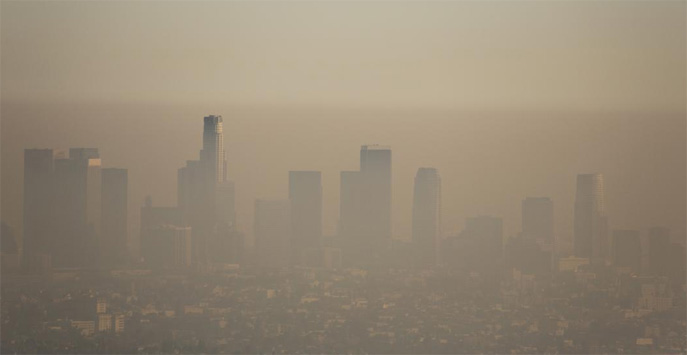
Los Angeles smog. Photo courtesy of the Sierra Club's My Generation campaign.
My parents told me I was born a fighter. As a newborn I was diagnosed with respiratory pneumonia and a heart murmur. I spent the first days of my life in an incubator and when I was finally allowed to go home the doctor cautioned my parents not to let me cry because it might damage my fragile lungs. For the first year of my life I was spoiled rotten until the doctor said “Let her cry now, she needs the exercise!”
At that time, I think most people, including doctors, were unaware of the importance of good air quality. Now that we are aware of how important it is, it’s crazy to me that some are willing to let air quality slide backward when we still have so much further to go for clean, safe air.
Growing up with smog was hard. As I got older, my breathing problems gradually worsened. As a “sensitive” child living in Southern California with horrendous smog pollution there were days when just getting ready for school was a challenge. I’d wake up still feeling tired with watery eyes, a runny nose, and a persistent wheeze in my chest, but the worst part was the odd bleach like smell in the air. I felt like I’d been dog-paddling in a swimming pool all night long and now I had to get up and go to school.
Being at school wasn’t any better. Back then, our teacher would tell us if we were having a Smog Alert day. If the alert was bad enough, recess was cancelled and we were kept inside to play board games. Unfortunately, our classrooms didn’t have air conditioning or filters so being inside wasn’t much better than being outside.
Smog Alerts came in three stages:
Stage 1 – Unhealthy.
Students were told to avoid anything that might cause hard breathing. If the teacher allowed us to go outside, were told to play quietly - no running, jumping, or competitive sports. Sensitive students (like me) were allowed to stay inside.
Stage 2 – Very Unhealthy.
No recess. We were even warned to walk slowly! A “Stage 2 Alert” also meant that after school sports, games and practices were cancelled.
Stage 3 – Hazardous. At this point, school districts had the option to cancel classes.
In 1974 the City of Upland, California, experienced the last recorded Stage 3 Smog alert in the entire country. The smog was so bad, Governor Ronald Reagan appeared on television to urge everyone “to limit all but absolutely necessary auto travel.”
Smog was first recognized as a problem in the Los Angeles air basin way back in the early 1940’s but the first Air Pollution Control District for L.A. County wasn’t created until 1947. Today, scientists and health care workers are still learning more about how smog affects the human body.
What we do know is that smog is very bad for all young people. A USC health study found that children and teens living in smoggy areas are five-times more likely to have clinically low lung function and childhood asthma rates can be as high as 14 percent.
Adults suffer as well. Smog damages lung tissue, increases the risk of developing certain types of cancer and contributes to cardiovascular disease and other chronic illnesses. I developed full blown asthma in college and got my first inhaler from a campus doctor.
After working so hard to improve air quality in Southern California, the entire southland is now at risk of slipping backward. This past summer of 2016 Southern California experienced the worst smog conditions in years. According to the Los Angeles Times: “In June, only four days had healthy air across the South Coast basin, which spans Los Angeles, Orange, Riverside and San Bernardino counties. In July, ozone levels violated federal health standards every day except July 31.”
We have never met Clean Air Act standards for safe air, and we have a long way to go. It is absolutely unacceptable that we are backsliding on progress. Please urge the South Coast Air Quality Management District to take a firm stand against polluters. We cannot forget the hazy yellow days of the past.